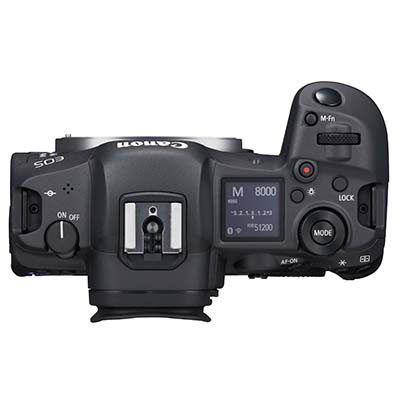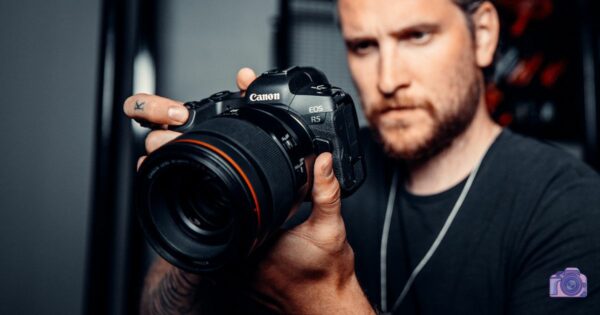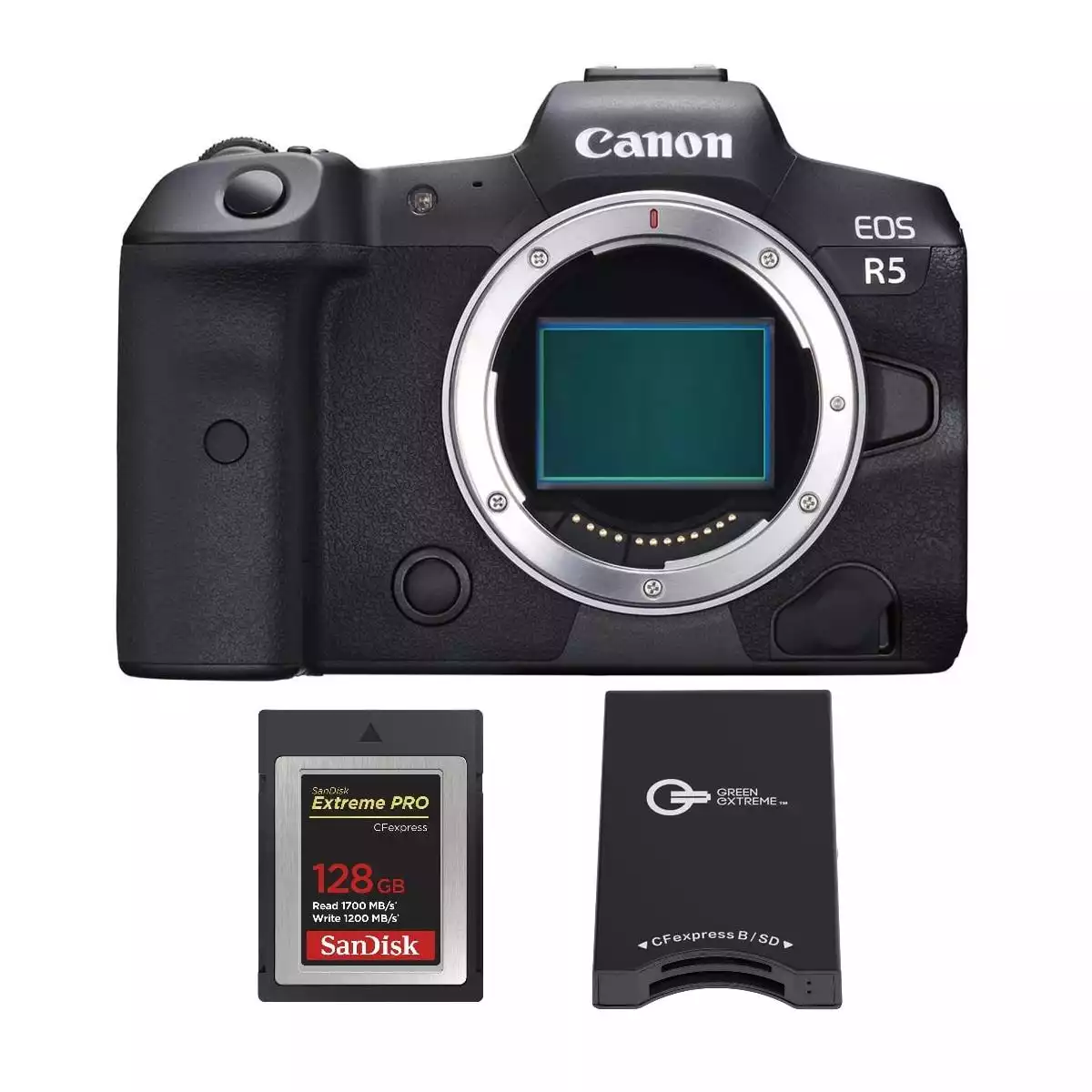After spending some quality time with the Canon EOS R5, I can confidently convey that this mirrorless powerhouse offers more than just a leap in filming technology. With its 45 Megapixel full-frame sensor, the image quality is nothing short of stellar. I was particularly excited about testing its 8K video capture capabilities, and it didn’t disappoint—each frame extracted as a 35.4 Megapixel still image showcased incredible detail.

I must admit, the EOS R5’s autofocus system is a game-changer. Whether I was capturing the fleeting moments of wildlife or snapping fast-paced sports action, the camera’s 1,053 AF zones with Dual Pixel CMOS AF II kept up remarkably, ensuring sharp images every time. What’s more, photographing pets became a trivial task with the Animal Detection AF. Meanwhile, the in-body image stabilization proved its worth, counteracting unwanted camera movement across a diverse range of scenarios.
OK, let’s jump into my full Canon EOS R5 review!

Although the camera is on the pricey side, the cost is somewhat justified given its top-notch performance and versatility. For filmmakers, earlier concerns about video recording have been addressed with firmware updates, which I found have significantly improved the camera’s reliability.
The EOS R5 is not just about shooting video; its dual card slots and high-resolution shot mode with the latest firmware are practical features that can be crucial for professional work. The connectivity options via Wi-Fi and Bluetooth are the icing on the cake for a seamless workflow.
Canon EOS R5 Review: Bottom Line
My time with the Canon EOS R5 was enlightening. The camera offers a professional level of performance that meets the needs of advanced amateur filmmakers. It stands as a testament to Canon’s commitment to innovation.
With features designed to capture life’s moments with unmatched clarity and detail, the R5 could very well be your next invaluable asset in photography.
Canon EOS R5 Overview
After spending some quality time with the R5, I must say it stands out for its staggering video capabilities. Its 45 Megapixel sensor captures details that are nothing short of brilliant, and the ability to shoot 8K video means you can grab extremely high-resolution stills from your footage, which is a plus for hybrid shooters like myself. Having used it extensively, I appreciate the camera’s speed—snapping up to 20 fps with its electronic shutter—and how it locks onto subjects. The autofocus system is a significant leap forward, especially with its animal detection feature which is incredibly useful for wildlife content creation.

I didn’t think I’d be swayed by the in-body image stabilization, but it’s impressive. Handheld shooting is far more forgiving now with an 8-stop stabilization. Even when pairing it with non-stabilized lenses, the results are still rock-solid. This camera’s connectivity options with Wi-Fi and Bluetooth are convenient for a quick image transfer. Dual card slots are another feature I find indispensable for managing overflow or backups, which is reassuring during critical shoots.
Although some may initially balk at the investment required, for serious filmmakers, the R5 justifies its price tag. I haven’t encountered severe overheating issues, as some early adopters had, suggesting that firmware updates have addressed the most pressing concerns. However, the camera’s weight and familiarity took some time to get used to, especially transitioning from older DSLR models. But once you get the hang of it, the R5 is a game-changer.
45 Megapixel Full-Frame Sensor
With its high resolution, the camera produces crisp and detailed images, which is especially noticeable when capturing landscapes and portraits where fine details are paramount. The sensor size is equivalent to 35mm, providing a broad field of view and contributing to the beautiful background blur that I love for depth of field effects.
However, this high resolution can also mean larger file sizes, which might be a consideration if you’re limited on storage space or need a faster workflow. But when it comes to print quality, the level of detail retained is impressive, allowing for large prints without losing image quality. From my experience, even when cropping photos heavily, there’s still plenty of detail left, which speaks volumes about the sensor’s capabilities.
In dim lighting conditions, the performance remains solid. The full-frame sensor means better light gathering capabilities, which is a boon for low light work. This does not necessarily imply flawless performance at high ISO settings – some noise is inevitable – yet the overall balance struck by the sensor is remarkable. Overall, my experiences with the R5’s sensor have left me impressed with its versatility and the sheer quality of images it can produce.
8K DCI Cinematic Movie Capture
When trying out the EOS R5’s 8K video recording, it’s nothing short of impressive. Capturing footage at such a high resolution allows for incredible detail, and I found that it opened up a new realm of possibilities for post-production, including cropping or extracting high-resolution stills without losing image quality.
One aspect that stood out to me was the capacity to record 8K videos using the full width of the sensor, which not only provides that sought-after cinematic look but also takes advantage of the camera’s stellar sensor performance. The output is crisp, with lifelike colors that require minimal adjustment in post.
However, this comes with a considerable demand for storage. Large file sizes are inevitable with 8K capture, and I noticed the need for high-capacity memory cards and a robust editing setup to handle the data.
In terms of user experience, the EOS R5 remains responsive even while dealing with this high-res mode, though I did observe that prolonged use could lead to overheating, which interrupts shooting.
While the 8K video is a game-changer for content creators seeking the highest quality, it requires some planning around storage solutions. Despite this, the visual results speak for themselves – they are truly professional-grade.
Speed and Autofocus Performance
The EOS R5 proves to be a powerhouse in terms of speed and responsiveness. The mechanical shutter zips through scenes at a brisk pace of up to 12 frames per second. This is a significant advantage when capturing fast-moving subjects, providing a smooth experience and rarely missing the mark. The autofocus system is a true standout; it swiftly locks onto subjects and tracks them with precision.
Even in challenging light conditions, the autofocus remains reliable—a testament to its robust design. Sensor shift image stabilization contributes to the clarity of shots, noticeable when shooting handheld in low-light situations or at slower shutter speeds. While there is much to admire, it is important to note that like any camera, the EOS R5 is subject to the occasional misfocus, but such instances are few and far between in my usage.
In-Body Image Stabilization
After putting the R5 through its paces, the standout feature for me has been its 5-axis in-body image stabilization (IBIS). It’s apparent that Canon has crafted this system to work in harmony with both non-stabilized and optically stabilized lenses, potentially offering up to 8 stops of shake correction.
In real-world use, this has translated to being able to shoot at significantly slower shutter speeds without compromising image sharpness. This is a huge boon for handheld shooting, especially in low-light conditions or when dealing with longer focal lengths.
However, it’s not just about stills; the stabilized footage while recording video also benefits greatly from this system, producing smooth and cinematic results that often might eliminate the need for a gimbal.
As for the downsides, while the stabilization is impressive, it can sometimes introduce a slight “float” when trying to lock down a perfectly static shot, which takes a little getting used to. Also, relying too heavily on IBIS can lead to a sense of overconfidence in challenging shooting scenarios where traditionally a tripod would have been mandatory.
Overall, the IBIS in the R5 is one of its strongest selling points, affirming Canon’s commitment to meet the needs of both photographers and videographers.
Pros and Cons
Having spent a fair amount of time with my Canon EOS R5, I feel confident giving you an insider’s look into its advantages and drawbacks.
Pros
- Image Quality. The 45-megapixel full-frame CMOS sensor provides exceptional image clarity. I’ve taken shots in varying light conditions and the detail is impressive, especially when you tweak the ISO settings.
- Speedy Shooting. At up to 12 fps with the mechanical shutter and 20 fps with the electronic shutter, capturing action shots is a breeze. I’ve never missed a beat, even at high-speed sporting events.
- Autofocus System. The Dual Pixel CMOS AF covers virtually the whole frame, with 1,053 AF areas. Tracking subjects has been incredibly accurate, whether I’m snapping photos of moving animals or athletes.
- Build and Handling. It feels great in hand. The weather-sealing offers peace of mind, letting me shoot in various environments without fretting over dust or moisture.
- Firmware Updates. Canon’s commitment to enhancing performance through firmware updates has been evident; the latest versions have fine-tuned the camera’s capabilities substantially.
Cons
- Price Point. The cost is steep and can be a barrier for many. However, based on my experience, it’s justified by the camera’s performance and feature set.
- Learning Curve. Transitioning to the R5 from other DSLR or older mirrorless models takes some adjustment. Initially, the controls and menus felt foreign, but after a week, operation became second nature.
- Video Recording Concern. There have been reports of overheating during video recording. Personally, as I focus more on stills, it hasn’t affected me, but it’s something videographers should consider.
- Battery Life. While adequate, the battery life hasn’t wowed me. For long shooting days, carrying spare batteries is a must.
Build and Ergonomics
In my hands, the Canon EOS R5 feels like a true example of Canon’s commitment to quality. The body is robust, and despite housing a full-frame sensor, it maintains an impressively manageable size. Balancing the camera during shoots is rarely a concern thanks to the ergonomic grip, which allows for a firm hold without strain over extended periods.
The materials used give it a premium feel, and the buttons and dials are well-placed, offering tactile feedback that I find both satisfying and functional. I’ve found that switching settings while keeping an eye on the subject is intuitive, enhancing the shooting experience without any fumbling for controls.
For those concerned with durability, the R5 does not disappoint. My time with the camera has shown that it can withstand the rigors of daily use. The dual card slots enhance that pro-level reliability, ensuring that backup is a breeze and I’m not left in the lurch after a long day of shooting.
However, the camera’s heft might be noticeable for those transitioning from lighter models or those particularly sensitive to weight when shooting handheld for long periods. The R5’s build is a testament to its high-end status, but the trade-off is the additional weight comparative to more compact mirrorless bodies.
Wireless Connectivity Features
I’m impressed by its wireless connectivity capabilities. The camera integrates seamlessly with Canon’s Camera Connect app. This connection gives you the flexibility to transfer images and control the camera remotely from your smartphone. For someone who values ease of upload and sharing, this feature is a boon, especially when working in the field. I noticed the Wi-Fi didn’t drop out and connected quite quickly to my devices.
I did face a small hiccup with the initial pairing process—it took me a few tries to establish a connection. But once set up, it was smooth sailing. The Bluetooth connectivity also contributes to a steady connection and allows for a quick switch between devices. It’s not perfect, but for a content creator looking for reliable wireless functionality to streamline their workflow, the R5 certainly delivers.
Customer Reviews
Many users, like myself, find the transition to mirrorless a bit unfamiliar at first, but the R5 quickly becomes second nature. The 45-megapixel sensor is a significant upgrade for folks coming from older Canon models, providing stunningly detailed images. As for videos, while some initial firmware concerns made waves, Canon’s updates have smoothed out those early wrinkles.
The cost is a notable consideration. It’s a premium investment, but in my experience, the performance justifies the expense for serious content creators. The sense of “wow” factor resonates with users, especially in image quality and the leap in technology compared to previous DSLRs like the 5D Mark IV.
Critiques are scarce, but they exist–mostly surrounding the price or the learning curve of the new system. Nonetheless, with an impressive average rating and a trove of satisfied photographers, my impression aligns with the consensus: the R5 is top-tier, especially when paired with Canon’s RF lenses. Its capabilities in handling various scenarios, from day-to-day photography to capturing the beauty of landscapes and wildlife, are exceptional.
Conclusion
After extensive hands-on time with the Canon EOS R5, my impressions of this camera are overwhelmingly positive. Despite its hefty price tag, the investment feels justified given the exceptional image quality and robust build. While video overheating issues were initially a concern, Canon’s firmware updates have addressed these problems to a significant extent.
I’ve found navigation on the R5 intuitive after a short learning curve, and the live exposure simulation feature is a game-changer for getting shots right in-camera. Moreover, the camera’s compatibility with EF lenses, using an adapter, extends its versatility without compromising performance.
And with a rating of 4.6 out of 5 stars, it’s clear that these views are echoed by many users.
The lofty standards set by the R5, from capturing extremely detailed images to providing a seamless user experience, make it not just a solid choice, but a benchmark in the full-frame mirrorless segment. Yes, you might need deep pockets for this camera, but if uncompromised image quality is your pursuit, the R5 is hard to beat.
Canon EOS R5 Mirrorless Camera with 128GB CFexpress Card, Reader.
Canon EOS R5

After spending some quality time with the Canon EOS R5, I can confidently convey that this mirrorless powerhouse offers more than just a leap in filming technology. With its 45 Megapixel full-frame sensor, the image quality is nothing short of stellar. I was particularly excited about testing its 8K video capture capabilities, and it didn’t disappoint—each frame extracted as a 35.4 Megapixel still image showcased incredible detail.
Product SKU: 4147C002
Product Brand: Canon
4.5
